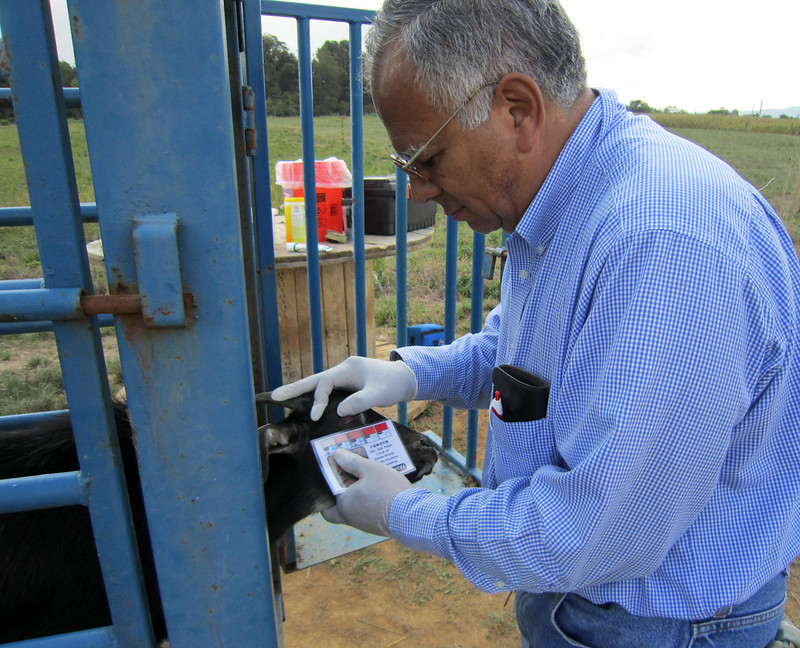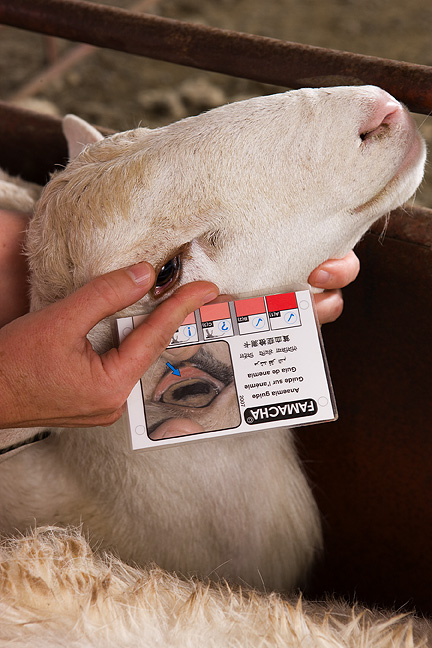Written by: Shanna Reynolds, Oglethorpe County Extension ANR Agent

Internal parasites are often the #1 health problem sheep and goats face in southeastern climates, with the most notorious of pests being the stomach worm, Haemonchus contortus, (aka the Barberpole worm). The industry can no longer rely on deworming drugs alone to control these bloodsuckers. All living organisms adapt to their environments leading to slow changes over time, and the Barberpole worm is very good at this adaptation. Overuse and misuse of dewormers speeds up those changes. Numerous studies have established that resistance to the three major classes of deworming drugs is widespread. An integrated parasite management approach is exactly what small ruminant producers need to win the battle against internal parasites on their farm.
Identifying the pest, or in this case parasite, you are dealing with is the first step in developing an Integrated Pest Management playbook. Understand the parasite biology/lifecycle and what causes their population to fluctuate throughout the year. Next, we can develop some management goals. Small ruminants will always carry some level of parasite burden. The goal should not be to create a parasite free animal, but to prevent clinical signs and production losses in a herd/flock. Through the use of the Five Point Check © (which includes FAMACHA© eyelid color scoring as a measure of anemia, bottle jaw, body condition scoring, fecal soiling scoring and nose drainage for sheep or coat condition for goats), a farm can establish threshold levels at which actions should be taken. Sheep and goats should not be dewormed on a predetermined schedule!

Under ideal management conditions we would like to see no animals show noticeable effects of parasitism. In reality, some will inevitably succumb to worm load. Monitoring parasite loads is important for a successful IPM system so that control methods can be performed at suitable times and management strategies can be evaluated and improved as needed. Producers can learn to recognize the signs of an internal parasite load and offer timely and effective treatment. As with any farm practice, monitoring methods must be simple and inexpensive. Some internal parasites, such as the Barberpole worm, will feed off their host’s blood, causing anemia and sometimes edema/swelling under the jaw (bottle jaw). The FAMACHA© system that assesses the level of anemia in sheep and goats by examining the eyelids of the animal is a reliable way to monitor this parasite. Parasites can cause symptoms such as diarrhea (not usually Barberpole worm), weight loss and rough hair coats. Fecal egg counting is another monitoring tool.
There are a number of control tactics that can be adopted in addition to an effective deworming protocol. Useful mechanical controls include stringent quarantine and sanitation practices. Separate new animals from a flock and treat with an effective deworming protocol to reduce the chance of introducing resistant parasites to a farm. Some parasites, such as coccidia, are spread through animals eating from fecal contaminated ground, feed troughs or water sources. Feed up off the ground, keep feeders and waterers clean, and clean manure from feeding and bedding areas frequently.
Biological controls use natural enemies to fight pests. Nematode-trapping fungus (Bioworma®) is a new tool recently available in the U.S. that interrupts the life cycle of parasites by trapping (and killing) larva in the feces.
Genetic control can involve selecting breeds that have shown parasite resistance. Regardless of breed, some animals are more resistant than others. Selecting for these animals over time and buying males that have parasite resistance (have not had to be dewormed but have been exposed to worms) can go a long way towards genetic control.
Cultural controls are where farms can see the biggest impact in parasite suppression. These practices reduce establishment, reproduction, distribution, and survival of parasites. Animals ingest larvae from pasture so the rate at which they are ingested can be controlled by intensive pasture management, including using reasonable stocking rates.
Worm larvae migrate from animal feces up blades of grasses where animals can eat them. Rotating sheep and goats off a pasture when the grazing is still at least 4-6 inches high decreases larvae ingestion. Having access to areas with browse allows animals to eat higher off the ground as well. Grazing sheep and goats in a rotation with horses or cattle can reduce parasite loads. Forages with high levels of condensed tannins such as sericea lespedeza also help lower infections.
Sheep and goats can also be raised on dry lot (pens with no grazing) so they do not eat contaminated forage. Animals have shown more tolerance of internal parasites when their immune systems are supported by good nutrition and proper mineral balance. Studies have also shown benefits of small doses of copper wire particles to control internal parasites (used as a dewormer).
Lastly, let’s talk about deworming drugs (anthelmintics) and how to use them effectively. I’m sure you’ve picked up on this theme by now, but I’ll state it once more. Strategic chemical controls should be used only on those animals that have been assessed via FAMACHA© or other parasite indications.
A first step is to determine which drugs are still effective on a farm. One option for assessing the effectiveness of a dewormer is by a fecal egg count reduction test – taking fecal samples before treating animals and again 10-14 days after treatment, then comparing the fecal egg count totals.
The American Consortium for Small Ruminant Parasite Control recommends strategies to best manage drug resistance. Animals should be dosed correctly by weighing animals on a scale or estimating weights with a tape prior to deworming. Goats need higher doses, so use appropriate deworming charts. Unless animals are very sick, restricting feed (overnight up to 24 hr) may intensify the effectiveness of dewormers. Rotating between drugs will not help prevent resistance but using a combination of dewormer classes together at the full dose is extremely helpful. Repeat dosing is also effective with certain drug classes. I would encourage all producers to visit www.wormx.info for more information on proper deworming protocols as well as to view upcoming FAMACHA© certifications.
With no new dewormers being developed, producers should do everything possible to slow down the development of drug resistance. Combining a number of the methods discussed in this article will lead to a more effective parasite management program than relying on anyone technique alone. Contact a knowledgeable veterinarian or local Extension agent to discuss local management strategies and work with a veterinarian to ensure proper use of deworming drugs.